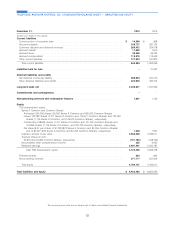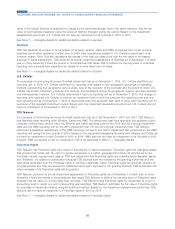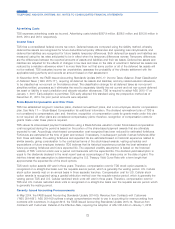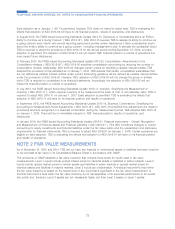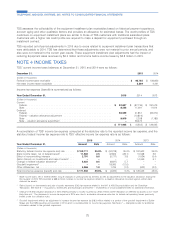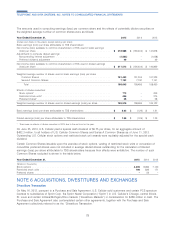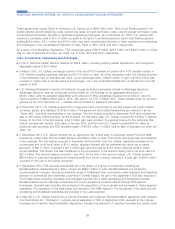US Cellular 2015 Annual Report Download - page 78
Download and view the complete annual report
Please find page 78 of the 2015 US Cellular annual report below. You can navigate through the pages in the report by either clicking on the pages listed below, or by using the keyword search tool below to find specific information within the annual report.
Debt Issuance Costs
Debt issuance costs include underwriters’ and legal fees and other charges related to issuing various borrowing
instruments and other long-term agreements, and are amortized over the respective term of each instrument. TDS early
adopted ASU 2015-03 using the retrospective method as of December 31, 2015. ASU 2015-03 requires certain debt
issuance costs to be presented in the balance sheet as an offset to the related debt obligation. Debt issuance costs
related to TDS and U.S. Cellular’s revolving credit facilities are excluded from the scope of ASU 2015-03 and are
recorded in Other assets and deferred charges in the Consolidated Balance Sheet. As a result of the retrospective
adoption, TDS reclassified unamortized debt issuance costs of $52.5 million as of December 31, 2014 from Other assets
and deferred charges to Long-term debt, net in the Consolidated Balance Sheet. Other than this reclassification, the
adoption of ASU 2015-03 did not have an impact on TDS’ consolidated financial statements.
Asset Retirement Obligations
TDS accounts for asset retirement obligations by recording the fair value of a liability for legal obligations associated with
an asset retirement in the period in which the obligations are incurred. At the time the liability is incurred, TDS records a
liability equal to the net present value of the estimated cost of the asset retirement obligation and increases the carrying
amount of the related long-lived asset by an equal amount. Until the obligation is fulfilled, TDS updates its estimates
relating to cash flows required and timing of settlement. TDS records the present value of the changes in the future
value as an increase or decrease to the liability and the related carrying amount of the long-lived asset. The liability is
accreted to future value over a period ending with the estimated settlement date of the respective asset retirement
obligation. The carrying amount of the long-lived asset is depreciated over the useful life of the related asset. Upon
settlement of the obligation, any difference between the cost to retire the asset and the recorded liability is recognized in
the Consolidated Statement of Operations.
Treasury Shares
Common Shares repurchased by TDS are recorded at cost as treasury shares and result in a reduction of equity. When
treasury shares are reissued, TDS determines the cost using the first-in, first-out cost method. The difference between
the cost of the treasury shares and reissuance price is included in Capital in excess of par value or Retained earnings.
Revenue Recognition
Revenues related to services are recognized as services are rendered. Revenues billed in advance or in arrears of the
services being provided are estimated and deferred or accrued, as appropriate.
Revenues from sales of equipment, products and accessories are recognized when TDS no longer has any
requirements to perform, when title has passed and when the products are accepted by the customer.
Multiple Deliverable Arrangements
U.S. Cellular and TDS Telecom sell multiple element service and equipment offerings. In these instances, revenues are
allocated using the relative selling price method. Under this method, arrangement consideration is allocated to each
element on the basis of its relative selling price. Revenue recognized for the delivered items is limited to the amount due
from the customer that is not contingent upon the delivery of additional products or services.
Loyalty Reward Program
In March 2015, U.S. Cellular announced that it would discontinue its loyalty reward program effective September 1, 2015.
All unredeemed reward points expired at that time and the deferred revenue balance of $58.2 million related to such
expired points was recognized as service revenues. At December 31, 2014, U.S. Cellular had deferred revenue related to
loyalty reward points outstanding of $94.6 million.
U.S. Cellular followed the deferred revenue method of accounting for its loyalty reward program. Under this method,
revenue allocated to loyalty reward points was deferred. The amount allocated to the loyalty points was based on the
estimated retail price of the products and services for which points may be redeemed divided by the number of loyalty
points required to receive such products and services. This was calculated on a weighted average basis and required
U.S. Cellular to estimate the percentage of loyalty points that would be redeemed for each product or service.
Revenue was recognized at the time of customer redemption or when such points were depleted via an account
maintenance charge. U.S. Cellular employed the proportional model to recognize revenues associated with breakage.
70
TELEPHONE AND DATA SYSTEMS, INC. NOTES TO CONSOLIDATED FINANCIAL STATEMENTS




